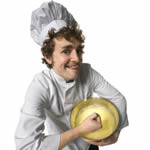2016/7/25 10:02:24

I'm a regular guy who likes to ride, race and tinker with mountain bikes. I also have the urge (since childhood) to take stuff apart to see how it works. Usually this behavior has helped me accumulate a good deal of worthless broken stuff. But one day, while cycling with my buddy Dave, my curiosity turned to goop. Specifically PowerBar Gel and GU.
Dave and I are the kind of guys that ride really hard. I don't think there's been an occasion where we decided to just take the next ride slow. Anyway, we usually down a few packets of energy gel on every ride. At about a dollar a pop, it doesn't take long until we realized the cost of all this. So one day on the trail, as I glanced at the ingredients of these parcels of fuel, I thought, "There's got to be a way to make this from scratch."
More: Eating to Win: What we Can Learn From Pro Cyclists
Flashback to Three Months Earlier
I'm at the local farmer's market buying Clover honey because of its reported benefits for combating allergy symptoms. I find a press release from the National Honey Board about a study showing positive results for use of honey as compared to other carbohydrate sources when used during competitive athletic training. That kind of stuck in my brain for a while.
Flashback to Present
So one rainy day later I was taking apart my PowerBar Gel. The packages are labeled with a wealth of information. Listed are the ingredients on the pack and the "Nutrition Facts" charts. In general, the important stuff in PowerBar Gel are the 25 grams of carbs, 45 milligrams of sodium, 35 milligrams of potassium, and the vitamins C and E.
More: Maintain Your Lean, Mean Racing Machine
The United States Department of Agriculture does a good job of getting those nutrition facts into their database. They actually have every food in the U.S. online at usda.gov. You can peruse and compare the nutritional content of Peanut Butter Cap'n Crunch versus Count Chocula if you like. My interest in their site was the abbreviated food database that I could download in a Microsoft Excel format. This document is the key to getting the nutritional content of any possible mixture of foods.
The first food item I looked up in the database was honey. Surprise! It has a bunch of good carbohydrates and vitamins in it. Honey alone is nutritionally very close to my goal of homebrew power goop, but it lacks a bit of sodium and potassium. So where can I get a good source of potassium? Mush up a banana? Maybe some nuts?
Suddenly, I find that molasses has a ton of potassium. If you can find blackstrap molasses, it has even more! As for the sodium, I'll just add some salt. So out of my research, here's the recipe:
More: Determine Your Century Nutrition Plan
Homebrew Power Goop
Be sure to mix everything together well. It should make enough to fill a five-serving GU flask.
This recipe works nicely. You may see some bubbles on the surface, but that is just a natural occurrence of the molasses. Neither honey nor molasses needs to be refrigerated, so you can keep it in your pocket all day and even use it the following week. I probably wouldn't go much past a week, but it should still be good.
The nutritional content approximates: 25g carbs, 45mg sodium, 35mg potassium--with plenty of vitamins and minerals that you wouldn't get with the store-bought stuff. Another nice thing about the honey recipe is that it is all natural. Honey comes from bees that get nectar from flowers. Molasses is refined from sugar cane. As Homer Simpson would say, "Mmmmm, suuuugggarrrrrr." Salt comes usually from salt mines, but you can always buy sea-salt and use that.
More: Fueling Up for the Ride
My experiment did not end at just plain ol' goop. It was still raining out, so I thought back to something I read somewhere about a 4-1 ratio of carbohydrates to protein. I guess that is supposed to be a good thing, so I made a recipe for it too.
Honey Goop With a Protein Kick
Mix everything together in a cup and add water as needed to develop a nice "goopable" consistency. Makes five servings.
I tried out some of this at the DINO 12-hour race, and it worked pretty well. The soy protein gave it a nice kick. I wouldn't leave this one in the sun for too long, though. Not that I've had any moss growing in it, but I would probably try to keep this one fresh.
More: 7 Tips for Fueling on the Bike
Now that I've freed the masses from cookie cutter carb-gels, I would like to say that this is not the end, but merely the beginning. These are just my recipes and, like the open source code of Linux, they are open for improvement and personalization. I haven't even started on anything with caffeine, but I imagine that you could substitute some espresso for the water or get wild with some ground-up ginseng supplements.
There is also the issue of flavoring. Could normal coffee flavoring work? Perhaps you can mix in some flavored Jell-O or Kool-Aid mix, or stay all-natural and mix in some lemon or orange zest. How about a jalapeno or two? The possibilities are endless.
More: 8 Tips to Lose Weight From Cycling
How to Control Your Emotions on Race Day
The challenge cyclists face is that different types of races and even different points in a rac
Century rides are considered a recreational cyclists ultimate endurance test. But with all the
Mind Games: Gaining a Psychological Edge on the Bike
My Legs Hurt! What are your thoughts really telling you and how can you turn it around to your benef
Contact management E-mail : [email protected]
Copyright © 2005-2016 Outdoor sports All Rights Reserved